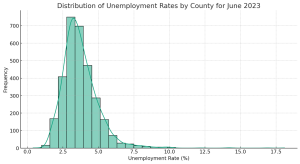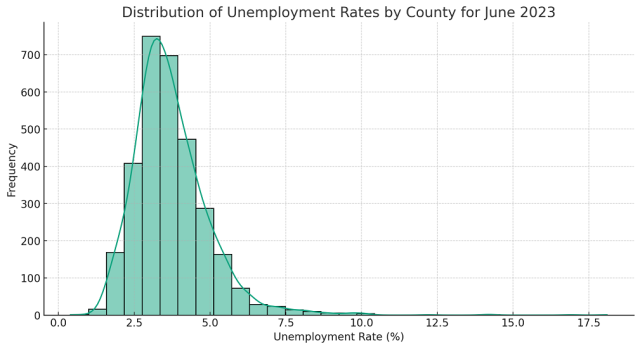
Unemployment figures often flood the news, painting a broad picture of economic stability or crisis. But have you ever wondered how these rates break down at the local level? Do certain counties (or cities) in different states fare better or worse than the national average, and if so, why? Unemployment is a critical indicator of economic health and social well-being. While national or state-level unemployment rates often make headlines, diving deeper into county-level or city level data can offer valuable insights for local governments, policymakers, and social organizations. In this blog, we will explore a dataset that provides unemployment rates for various U.S. counties in June 2023. Along the way, we’ll highlight actionable insights that can be gleaned from this data. We will use Python code for demonstration purpose.
Unemployment Dataset Overview
The dataset comprises unemployment rates for 3,139 U.S. counties for the month of June 2023. It features the following columns:
- Series ID: A unique identifier for each county’s data series.
- Region Name: The name of the county, along with its state abbreviation.
- Region Code: A numerical code representing the county.
- Unemployment Rate: The unemployment rate for June 2023 in percentage.
Summary Statistics on Unemployment
Before diving into the dataset, it’s essential to understand the data’s general landscape through summary statistics:
- Count: There are 3,139 entries, indicating data for 3,139 counties.
- Mean: The average unemployment rate is approximately 3.73%.
- Standard Deviation: The standard deviation is approximately 1.29, indicating the extent to which individual unemployment rates deviate from the mean.
- Minimum: The lowest recorded unemployment rate is 0.4%.
- 25th Percentile (Q1): 25% of the counties have an unemployment rate of 2.9% or lower.
- Median (50th Percentile): The median unemployment rate is 3.5%.
- 75th Percentile (Q3): 75% of the counties have an unemployment rate of 4.3% or lower.
- Maximum: The highest recorded unemployment rate is 18.1%
These statistics show that while most counties have stable employment conditions, there are areas with significantly high unemployment rates requiring immediate attention.
The following Python code can be used to get the above summary statistics:
import pandas as pd
# Load the CSV file into a DataFrame
file_path = '/path/2023 June Unemployment Rate by County (Percent).csv'
df = pd.read_csv(file_path)
# Generate summary statistics for the numerical columns
summary_stats = df.describe()
summary_stats
Visualizing the Unemployment Dataset
A histogram depicting the distribution of unemployment rates reveals a somewhat positively skewed distribution. Most counties have unemployment rates between 2% and 5%, but there are outliers with alarmingly high rates. The following Python code can be used to view the data distribution of unemployment rates.
First and foremost, we perform the data cleaning.
# Rename the columns based on the first row and drop the first row
df.columns = df.iloc[0]
df = df.drop(df.index[0])
# Reset the index
df.reset_index(drop=True, inplace=True)
# Convert the '01-06-2023' column to numeric, as it contains the unemployment rate
df['01-06-2023'] = pd.to_numeric(df['01-06-2023'], errors='coerce')
Once the data is cleaned, we go for plotting the distribution plot.
import matplotlib.pyplot as plt
import seaborn as sns
# Set the style for the visualization
sns.set(style="whitegrid")
# Create a histogram to visualize the distribution of the unemployment rates
plt.figure(figsize=(12, 6))
sns.histplot(df['01-06-2023'], bins=30, kde=True)
plt.title('Distribution of Unemployment Rates by Country for June 2023')
plt.xlabel('Unemployment Rate (%)')
plt.ylabel('Frequency')
plt.show()

From the distribution plot, we can observe that:
- The majority of the counties have an unemployment rate between approximately 2% and 5%.
- The distribution seems to be somewhat positively skewed, meaning there are fewer counties with very high unemployment rates.
Actionable Insights on Unemployment
General Insights
- Focus on High Unemployment Areas: The maximum unemployment rate is 18.1%, which is significantly higher than the average rate of 3.73%. These areas may require urgent intervention programs.
- Stable Employment in Many Areas: With a median unemployment rate of 3.5%, the majority of the counties seem to have relatively stable employment conditions. This could indicate that existing employment policies are effective for most regions.
- Diverse Employment Landscape: The standard deviation of 1.29 suggests that there is a wide range of unemployment rates across different counties. Policymakers should consider this diversity when designing employment programs.
Action Steps
- Targeted Job Creation: High unemployment areas could benefit from targeted job creation initiatives.
- Skill Development Programs: Training programs can improve employability in high unemployment regions.
- Policy Review: Low unemployment areas can serve as models for effective employment policies.
- Emergency Support: Extremely high unemployment areas may require immediate financial or food support.
- Data-Driven Monitoring: Continuously monitor data to adapt and tailor initiatives.
- Cross-County Collaboration: Sharing successful policies and strategies between counties could be beneficial.
Conclusion
County-level unemployment data can offer a wealth of insights for creating more effective employment policies and social programs. By focusing on areas with particularly high or low unemployment rates, and by tailoring strategies to the specific needs of each region, policymakers and community leaders can make more informed decisions that benefit everyone.
And there you have it! A deep dive into a real-world unemployment dataset and the actionable insights that can be drawn from it. With data-driven approaches, we can not only understand the present landscape but also shape future strategies for economic and social well-being.
- Coefficient of Variation in Regression Modelling: Example - November 9, 2025
- Chunking Strategies for RAG with Examples - November 2, 2025
- RAG Pipeline: 6 Steps for Creating Naive RAG App - November 1, 2025
I found it very helpful. However the differences are not too understandable for me